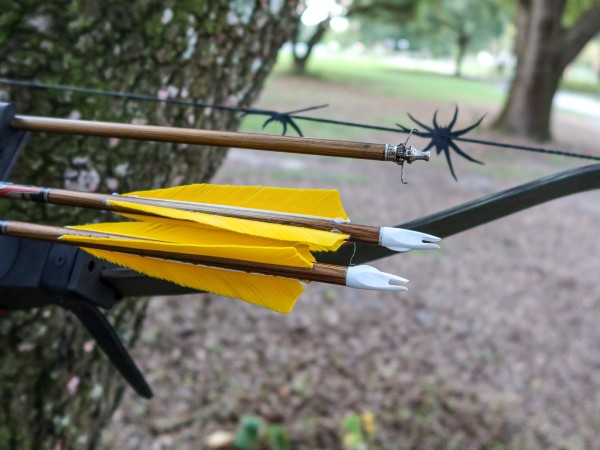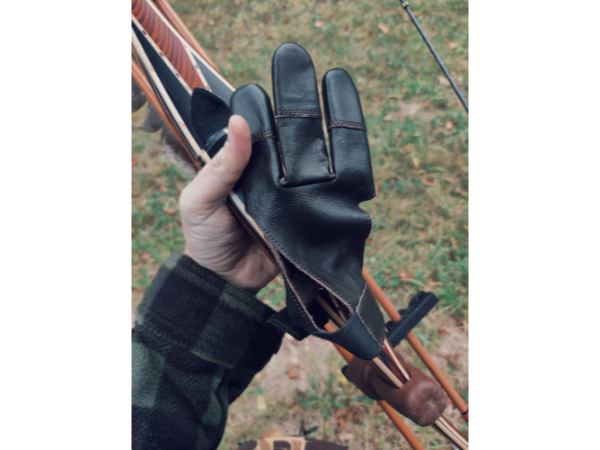After two years of practicing with my bow as much as possible—enough to have worn out four hay bales and a few dozen arrows—I felt ready to try hunting deer with it at age thirteen. Even though some people questioned whether I was ready, I bought a deer tag and started calling around. It was not long before I got a call from our neighbor giving me permission to hunt on his property.
Immediately after getting the call, I decided to do some scouting. Even though the property is small (only about fifty acres), it lies right in the middle of some prime deer habitat in the rolling hills of coastal California. Towering Douglas fir trees loom above live oak and tan oak trees. On the property, there is a small pond lined with cattails and a small abandoned apple orchard that has become a maze of deer trails. I spent several hours looking for deer sign, and found lots around the pond and in the apple orchard. On my way back I spooked two deer—a doe and a buck.
The next morning found me sneaking down to the apple orchard in the early morning fog. I froze and watched as the two deer slipped into the clearing and started feeding on apples only ten yards from me, but I could not shoot because the grass was too tall and I was kneeling. I tried to crawl to a place where I could shoot from, but the wind shifted and the deer bounded off. I figured that the deer would return later and was happy to have found the deer so soon.
My brother and I returned later that day to make a blind. After some searching, we found a small stretch of fence overgrown by blackberries. Using a pair of loppers, I managed to clear a little shooting window through the wall of berry vines and fence wire. I practiced a few shots to make sure that I could shoot through such a small opening. I also found an old tire lying around that I set up as a seat.
I did not hunt that evening, but I was up well before light the next morning. By the time I got to my blind it was just getting light, and as I settled down to wait, an acorn woodpecker flew over and started feeding on apples and scolding me. After an hour of sitting, the old tire started to get very uncomfortable. I waited another forty-five minutes before deciding to go home and make a stool to sit on.
I spent most of that day shooting my bow and making a stool, and around three in the afternoon I went back up to the blind with my brother. The plan was that my brother was going to sit up in a tree above me and watch where the deer went if I shot one, but as little brothers are, he only lasted an hour before climbing down the tree, breaking branches, and abandoning me. I spent several hours listening to the grey squirrel above me feeding on bay nuts while I read Fred Asbell’s book, Instinctive Shooting. I was just thinking it was about the time the deer would be coming, if they came at all, when I heard a songbird alarm. A minute later the buck appeared and started feeding on apples, ten yards from me.
I slowly picked up my bow and waited for him to offer a shot. After what seemed like hours, he turned broadside. I started to draw my bow but his head shot up and caught me at half draw for thirty seconds. When he finally put his head down to feed I was shaking from holding my bow back so long, so I let down and drew again. This time I released and watched as my arrow flashed through the buck. It seemed as though the deer was already moving as my arrow hit. I cupped my ears, listened, and heard him bounding off and then one last crash. And then—nothing.
I walked over to where the deer had been standing and found my arrow buried in the grass, coated with blood. I also found a little bit of blood splattered in the grass where the deer had been standing. I thought the shot had been good, but decided to give it some time just in case, so I slipped out and returned home for help. Upon arriving, I told my family the story and ate dinner. By that time it was dark, so after finishing dinner we grabbed flashlights and started walking up to the apple orchard. We did not find any blood for the first twenty yards, and I was starting to get worried.
I finally found a few spots of blood, and after that there got to be more and more until I shone my flashlight beam ahead and spotted the buck lying dead under a big oak tree. I could hardly believe it! I had just hunted my first deer. After thanking the deer for his life, we field dressed and started carrying him out on a fir pole that we cut. It took us a while and, even though it was not a big deer, it sure did feel heavy by the time we got to our house.
We hung the deer in a tree and I went to bed happy, tired, and thankful. I was up early the next morning skinning and butchering the buck.
That evening some friends came over and we had a feast of ribs, backstrap, and apple venison sausage in celebration of my first deer.

Demetri, in the brain-tanned jacket he made from hides he tanned, with his bow and blacktail skull.
Equipment Notes: On this hunt, Demetri used a 40# Shakespeare recurve, Traditional Only carbon arrows, and 140-grain Grizzly broadheads.







That’s a wonderful story, Demitri! I felt like I was right there with you, sir. Congratulations on beginning your journey as a bowhunter. It’s about as much fun as a person can have, in my opinion, and you are doing it ‘right’ ! Best of luck to you and keep writing down your stories…we all want to hear how things go. That’s a great jacket by the way….nice job on the brain tan. Owen Jeffreys, the master bowyer for Shakespeare until he bought the company and called it Jeffrey Archery would be proud to know you are shooting one of his fine bows, too!